David Game College - Integrated Emergency Management Report Analysis
VerifiedAdded on 2023/01/12
|9
|2184
|98
Report
AI Summary
This report delves into the realm of integrated emergency management, examining the roles and responsibilities of various public services, including the police, fire services, the NHS, and the military, in the context of emergency incidents. The report begins by outlining relevant legislation, such as the Civil Contingencies Act 2004 and the Fire and Rescue Services Act 2004, which define the powers and duties of these agencies. It then analyzes the responsibilities of each service based on the Joint Emergency Services Interoperability Principles (JESIP), emphasizing collaboration and coordination. The report also explores the different roles played by public service agencies during a major incident, using the Flixborough disaster as a case study, and highlights the planning steps taken to ensure an effective response, emphasizing the importance of working together, gathering information, and assessing risks. The conclusion underscores the significance of inter-agency cooperation for public safety.
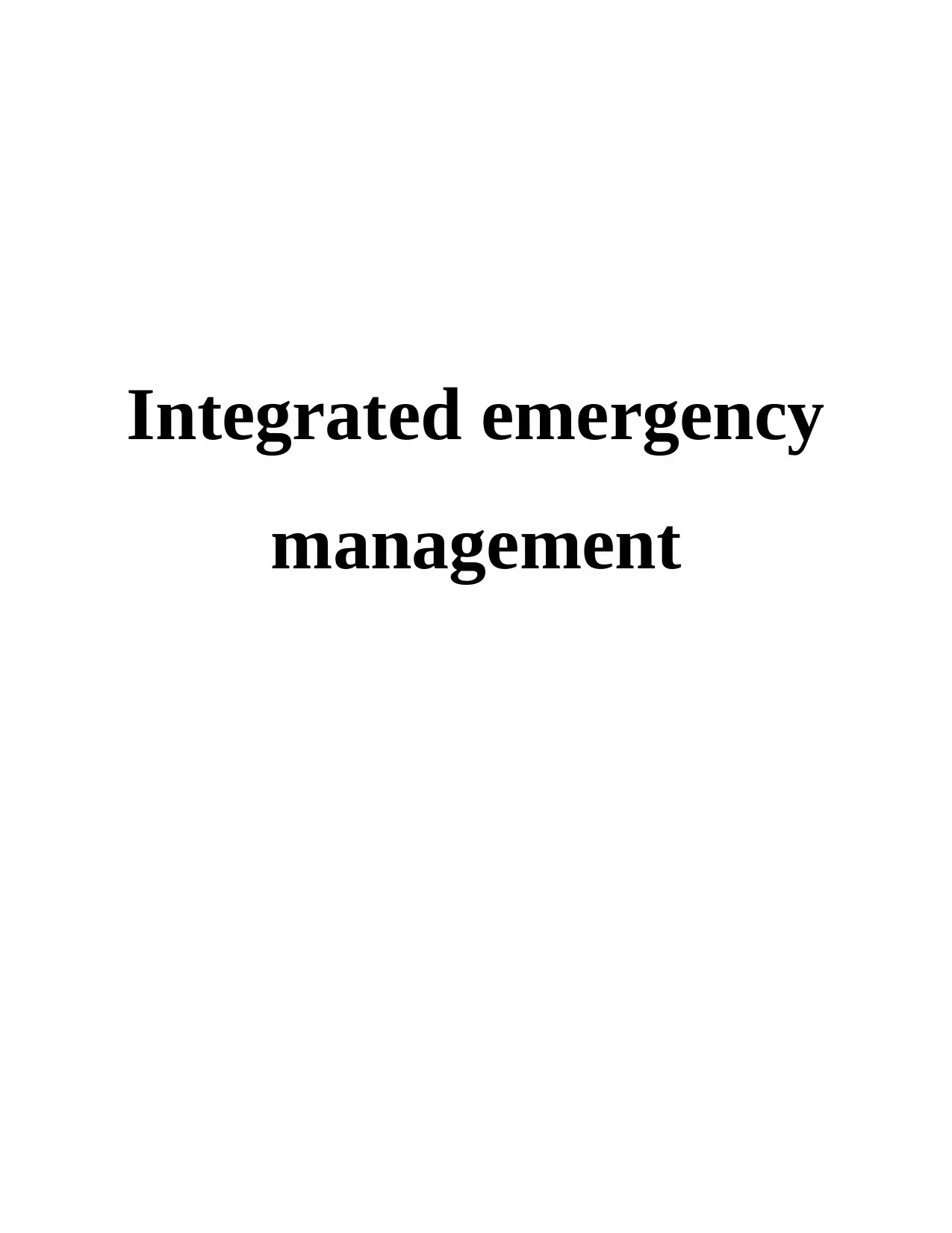
Integrated emergency
management
management
Paraphrase This Document
Need a fresh take? Get an instant paraphrase of this document with our AI Paraphraser
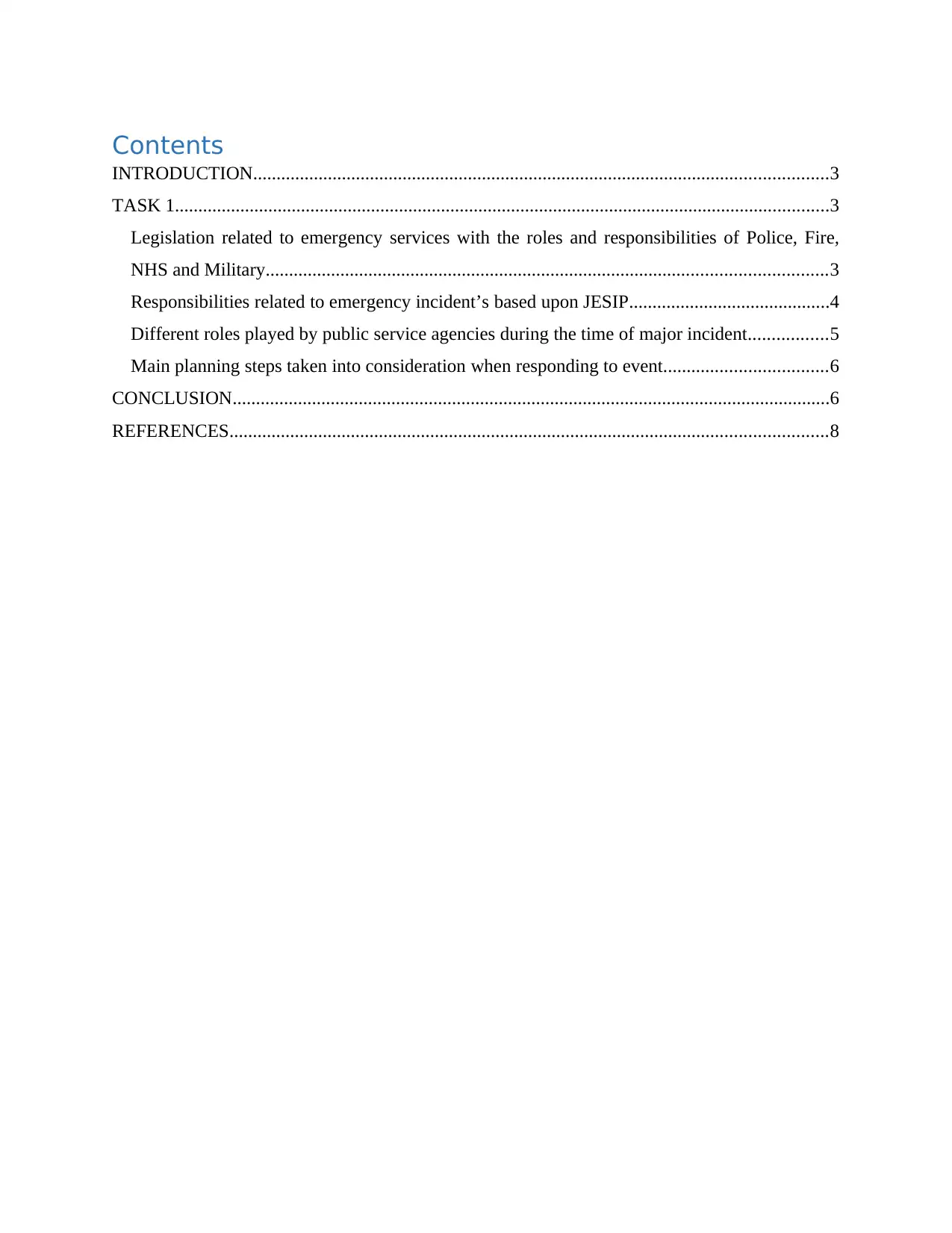
Contents
INTRODUCTION...........................................................................................................................3
TASK 1............................................................................................................................................3
Legislation related to emergency services with the roles and responsibilities of Police, Fire,
NHS and Military........................................................................................................................3
Responsibilities related to emergency incident’s based upon JESIP...........................................4
Different roles played by public service agencies during the time of major incident.................5
Main planning steps taken into consideration when responding to event...................................6
CONCLUSION................................................................................................................................6
REFERENCES................................................................................................................................8
INTRODUCTION...........................................................................................................................3
TASK 1............................................................................................................................................3
Legislation related to emergency services with the roles and responsibilities of Police, Fire,
NHS and Military........................................................................................................................3
Responsibilities related to emergency incident’s based upon JESIP...........................................4
Different roles played by public service agencies during the time of major incident.................5
Main planning steps taken into consideration when responding to event...................................6
CONCLUSION................................................................................................................................6
REFERENCES................................................................................................................................8
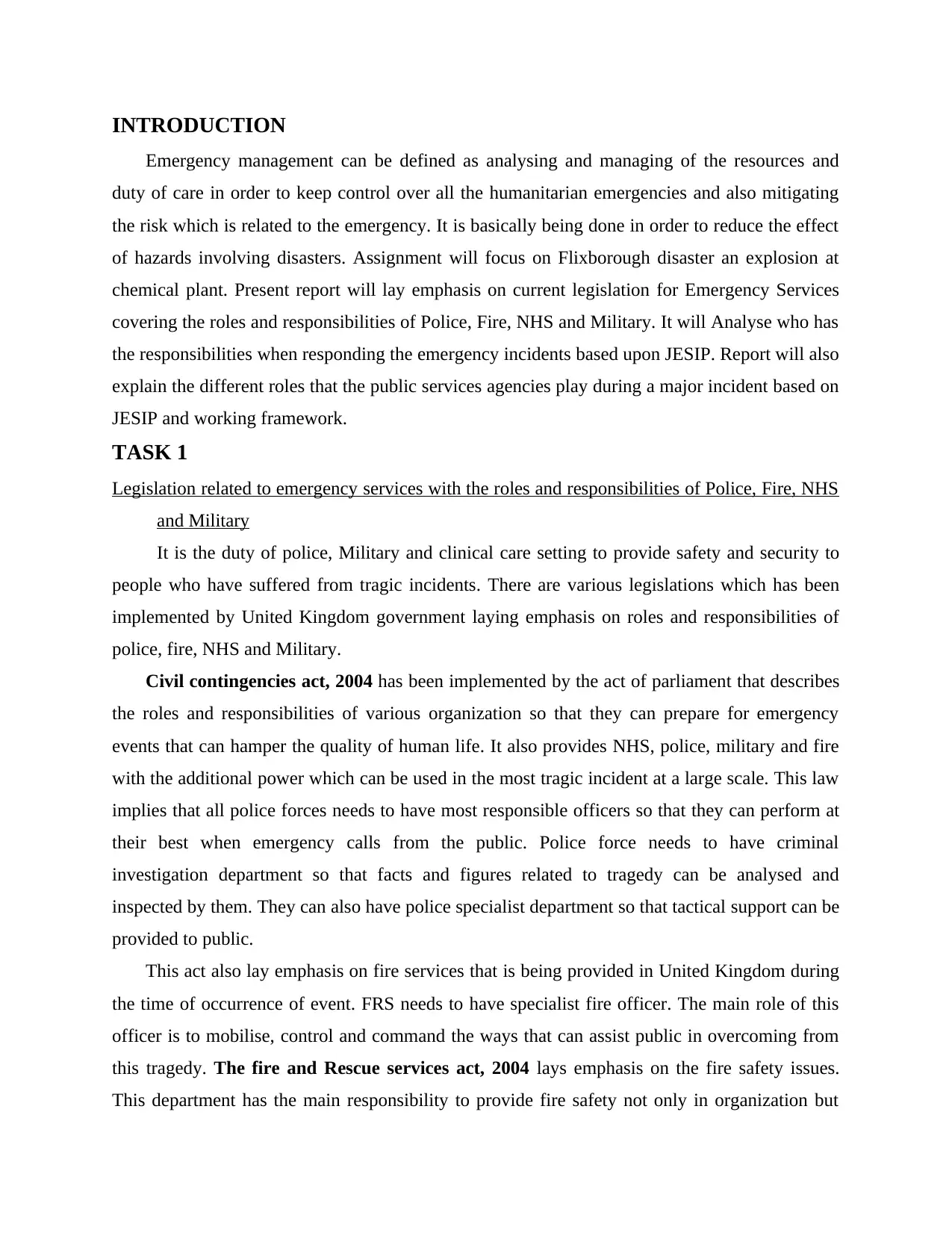
INTRODUCTION
Emergency management can be defined as analysing and managing of the resources and
duty of care in order to keep control over all the humanitarian emergencies and also mitigating
the risk which is related to the emergency. It is basically being done in order to reduce the effect
of hazards involving disasters. Assignment will focus on Flixborough disaster an explosion at
chemical plant. Present report will lay emphasis on current legislation for Emergency Services
covering the roles and responsibilities of Police, Fire, NHS and Military. It will Analyse who has
the responsibilities when responding the emergency incidents based upon JESIP. Report will also
explain the different roles that the public services agencies play during a major incident based on
JESIP and working framework.
TASK 1
Legislation related to emergency services with the roles and responsibilities of Police, Fire, NHS
and Military
It is the duty of police, Military and clinical care setting to provide safety and security to
people who have suffered from tragic incidents. There are various legislations which has been
implemented by United Kingdom government laying emphasis on roles and responsibilities of
police, fire, NHS and Military.
Civil contingencies act, 2004 has been implemented by the act of parliament that describes
the roles and responsibilities of various organization so that they can prepare for emergency
events that can hamper the quality of human life. It also provides NHS, police, military and fire
with the additional power which can be used in the most tragic incident at a large scale. This law
implies that all police forces needs to have most responsible officers so that they can perform at
their best when emergency calls from the public. Police force needs to have criminal
investigation department so that facts and figures related to tragedy can be analysed and
inspected by them. They can also have police specialist department so that tactical support can be
provided to public.
This act also lay emphasis on fire services that is being provided in United Kingdom during
the time of occurrence of event. FRS needs to have specialist fire officer. The main role of this
officer is to mobilise, control and command the ways that can assist public in overcoming from
this tragedy. The fire and Rescue services act, 2004 lays emphasis on the fire safety issues.
This department has the main responsibility to provide fire safety not only in organization but
Emergency management can be defined as analysing and managing of the resources and
duty of care in order to keep control over all the humanitarian emergencies and also mitigating
the risk which is related to the emergency. It is basically being done in order to reduce the effect
of hazards involving disasters. Assignment will focus on Flixborough disaster an explosion at
chemical plant. Present report will lay emphasis on current legislation for Emergency Services
covering the roles and responsibilities of Police, Fire, NHS and Military. It will Analyse who has
the responsibilities when responding the emergency incidents based upon JESIP. Report will also
explain the different roles that the public services agencies play during a major incident based on
JESIP and working framework.
TASK 1
Legislation related to emergency services with the roles and responsibilities of Police, Fire, NHS
and Military
It is the duty of police, Military and clinical care setting to provide safety and security to
people who have suffered from tragic incidents. There are various legislations which has been
implemented by United Kingdom government laying emphasis on roles and responsibilities of
police, fire, NHS and Military.
Civil contingencies act, 2004 has been implemented by the act of parliament that describes
the roles and responsibilities of various organization so that they can prepare for emergency
events that can hamper the quality of human life. It also provides NHS, police, military and fire
with the additional power which can be used in the most tragic incident at a large scale. This law
implies that all police forces needs to have most responsible officers so that they can perform at
their best when emergency calls from the public. Police force needs to have criminal
investigation department so that facts and figures related to tragedy can be analysed and
inspected by them. They can also have police specialist department so that tactical support can be
provided to public.
This act also lay emphasis on fire services that is being provided in United Kingdom during
the time of occurrence of event. FRS needs to have specialist fire officer. The main role of this
officer is to mobilise, control and command the ways that can assist public in overcoming from
this tragedy. The fire and Rescue services act, 2004 lays emphasis on the fire safety issues.
This department has the main responsibility to provide fire safety not only in organization but
⊘ This is a preview!⊘
Do you want full access?
Subscribe today to unlock all pages.

Trusted by 1+ million students worldwide
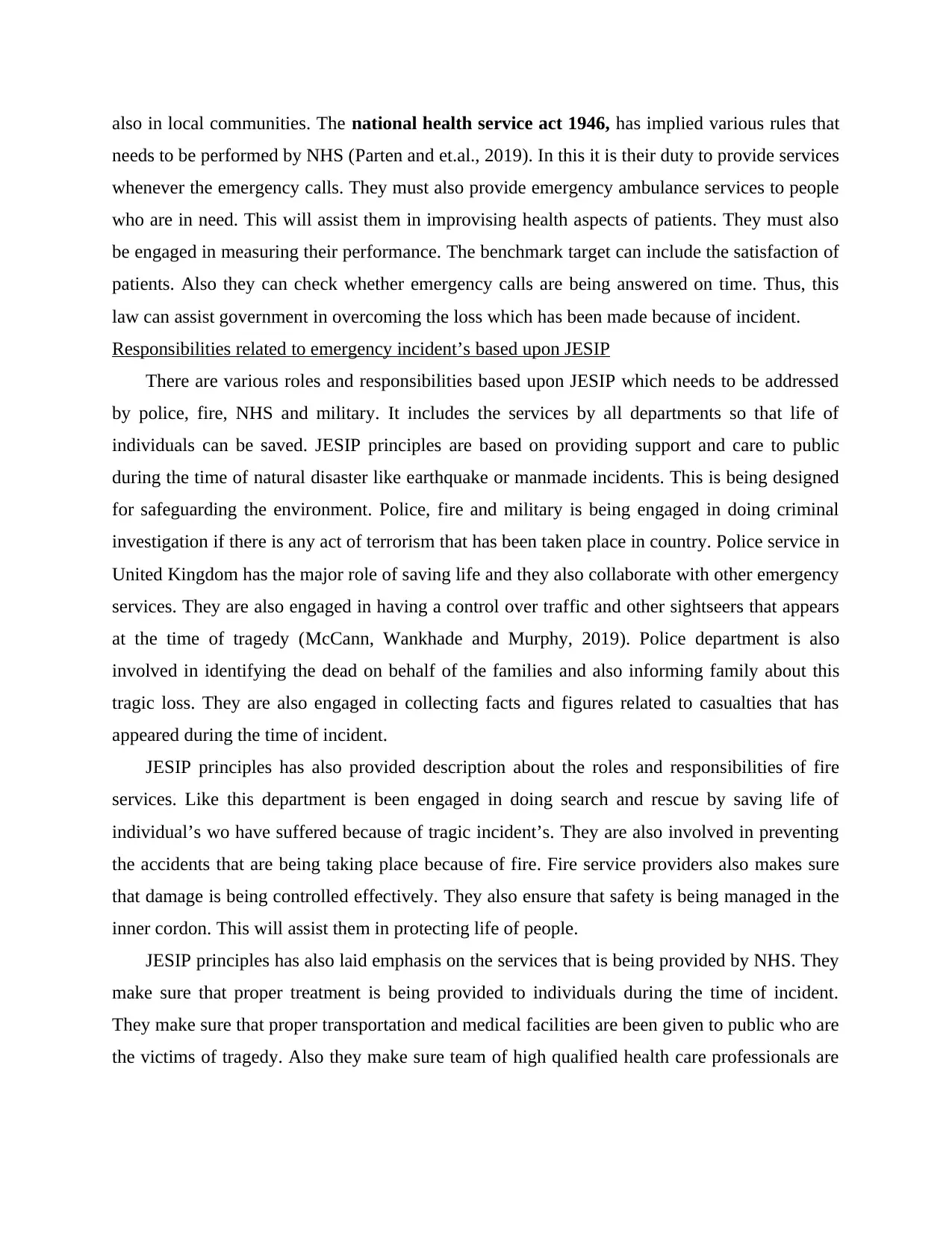
also in local communities. The national health service act 1946, has implied various rules that
needs to be performed by NHS (Parten and et.al., 2019). In this it is their duty to provide services
whenever the emergency calls. They must also provide emergency ambulance services to people
who are in need. This will assist them in improvising health aspects of patients. They must also
be engaged in measuring their performance. The benchmark target can include the satisfaction of
patients. Also they can check whether emergency calls are being answered on time. Thus, this
law can assist government in overcoming the loss which has been made because of incident.
Responsibilities related to emergency incident’s based upon JESIP
There are various roles and responsibilities based upon JESIP which needs to be addressed
by police, fire, NHS and military. It includes the services by all departments so that life of
individuals can be saved. JESIP principles are based on providing support and care to public
during the time of natural disaster like earthquake or manmade incidents. This is being designed
for safeguarding the environment. Police, fire and military is being engaged in doing criminal
investigation if there is any act of terrorism that has been taken place in country. Police service in
United Kingdom has the major role of saving life and they also collaborate with other emergency
services. They are also engaged in having a control over traffic and other sightseers that appears
at the time of tragedy (McCann, Wankhade and Murphy, 2019). Police department is also
involved in identifying the dead on behalf of the families and also informing family about this
tragic loss. They are also engaged in collecting facts and figures related to casualties that has
appeared during the time of incident.
JESIP principles has also provided description about the roles and responsibilities of fire
services. Like this department is been engaged in doing search and rescue by saving life of
individual’s wo have suffered because of tragic incident’s. They are also involved in preventing
the accidents that are being taking place because of fire. Fire service providers also makes sure
that damage is being controlled effectively. They also ensure that safety is being managed in the
inner cordon. This will assist them in protecting life of people.
JESIP principles has also laid emphasis on the services that is being provided by NHS. They
make sure that proper treatment is being provided to individuals during the time of incident.
They make sure that proper transportation and medical facilities are been given to public who are
the victims of tragedy. Also they make sure team of high qualified health care professionals are
needs to be performed by NHS (Parten and et.al., 2019). In this it is their duty to provide services
whenever the emergency calls. They must also provide emergency ambulance services to people
who are in need. This will assist them in improvising health aspects of patients. They must also
be engaged in measuring their performance. The benchmark target can include the satisfaction of
patients. Also they can check whether emergency calls are being answered on time. Thus, this
law can assist government in overcoming the loss which has been made because of incident.
Responsibilities related to emergency incident’s based upon JESIP
There are various roles and responsibilities based upon JESIP which needs to be addressed
by police, fire, NHS and military. It includes the services by all departments so that life of
individuals can be saved. JESIP principles are based on providing support and care to public
during the time of natural disaster like earthquake or manmade incidents. This is being designed
for safeguarding the environment. Police, fire and military is being engaged in doing criminal
investigation if there is any act of terrorism that has been taken place in country. Police service in
United Kingdom has the major role of saving life and they also collaborate with other emergency
services. They are also engaged in having a control over traffic and other sightseers that appears
at the time of tragedy (McCann, Wankhade and Murphy, 2019). Police department is also
involved in identifying the dead on behalf of the families and also informing family about this
tragic loss. They are also engaged in collecting facts and figures related to casualties that has
appeared during the time of incident.
JESIP principles has also provided description about the roles and responsibilities of fire
services. Like this department is been engaged in doing search and rescue by saving life of
individual’s wo have suffered because of tragic incident’s. They are also involved in preventing
the accidents that are being taking place because of fire. Fire service providers also makes sure
that damage is being controlled effectively. They also ensure that safety is being managed in the
inner cordon. This will assist them in protecting life of people.
JESIP principles has also laid emphasis on the services that is being provided by NHS. They
make sure that proper treatment is being provided to individuals during the time of incident.
They make sure that proper transportation and medical facilities are been given to public who are
the victims of tragedy. Also they make sure team of high qualified health care professionals are
Paraphrase This Document
Need a fresh take? Get an instant paraphrase of this document with our AI Paraphraser
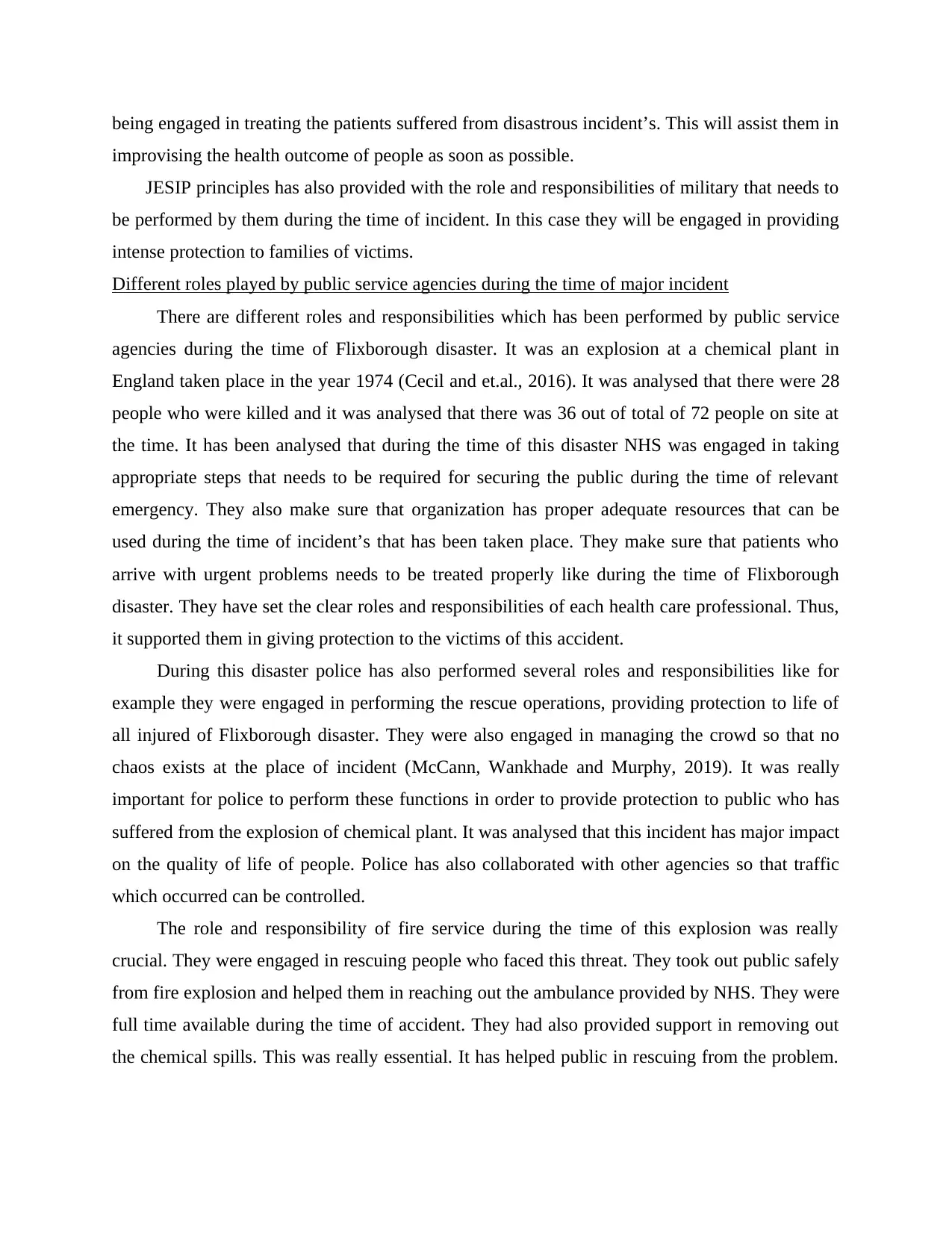
being engaged in treating the patients suffered from disastrous incident’s. This will assist them in
improvising the health outcome of people as soon as possible.
JESIP principles has also provided with the role and responsibilities of military that needs to
be performed by them during the time of incident. In this case they will be engaged in providing
intense protection to families of victims.
Different roles played by public service agencies during the time of major incident
There are different roles and responsibilities which has been performed by public service
agencies during the time of Flixborough disaster. It was an explosion at a chemical plant in
England taken place in the year 1974 (Cecil and et.al., 2016). It was analysed that there were 28
people who were killed and it was analysed that there was 36 out of total of 72 people on site at
the time. It has been analysed that during the time of this disaster NHS was engaged in taking
appropriate steps that needs to be required for securing the public during the time of relevant
emergency. They also make sure that organization has proper adequate resources that can be
used during the time of incident’s that has been taken place. They make sure that patients who
arrive with urgent problems needs to be treated properly like during the time of Flixborough
disaster. They have set the clear roles and responsibilities of each health care professional. Thus,
it supported them in giving protection to the victims of this accident.
During this disaster police has also performed several roles and responsibilities like for
example they were engaged in performing the rescue operations, providing protection to life of
all injured of Flixborough disaster. They were also engaged in managing the crowd so that no
chaos exists at the place of incident (McCann, Wankhade and Murphy, 2019). It was really
important for police to perform these functions in order to provide protection to public who has
suffered from the explosion of chemical plant. It was analysed that this incident has major impact
on the quality of life of people. Police has also collaborated with other agencies so that traffic
which occurred can be controlled.
The role and responsibility of fire service during the time of this explosion was really
crucial. They were engaged in rescuing people who faced this threat. They took out public safely
from fire explosion and helped them in reaching out the ambulance provided by NHS. They were
full time available during the time of accident. They had also provided support in removing out
the chemical spills. This was really essential. It has helped public in rescuing from the problem.
improvising the health outcome of people as soon as possible.
JESIP principles has also provided with the role and responsibilities of military that needs to
be performed by them during the time of incident. In this case they will be engaged in providing
intense protection to families of victims.
Different roles played by public service agencies during the time of major incident
There are different roles and responsibilities which has been performed by public service
agencies during the time of Flixborough disaster. It was an explosion at a chemical plant in
England taken place in the year 1974 (Cecil and et.al., 2016). It was analysed that there were 28
people who were killed and it was analysed that there was 36 out of total of 72 people on site at
the time. It has been analysed that during the time of this disaster NHS was engaged in taking
appropriate steps that needs to be required for securing the public during the time of relevant
emergency. They also make sure that organization has proper adequate resources that can be
used during the time of incident’s that has been taken place. They make sure that patients who
arrive with urgent problems needs to be treated properly like during the time of Flixborough
disaster. They have set the clear roles and responsibilities of each health care professional. Thus,
it supported them in giving protection to the victims of this accident.
During this disaster police has also performed several roles and responsibilities like for
example they were engaged in performing the rescue operations, providing protection to life of
all injured of Flixborough disaster. They were also engaged in managing the crowd so that no
chaos exists at the place of incident (McCann, Wankhade and Murphy, 2019). It was really
important for police to perform these functions in order to provide protection to public who has
suffered from the explosion of chemical plant. It was analysed that this incident has major impact
on the quality of life of people. Police has also collaborated with other agencies so that traffic
which occurred can be controlled.
The role and responsibility of fire service during the time of this explosion was really
crucial. They were engaged in rescuing people who faced this threat. They took out public safely
from fire explosion and helped them in reaching out the ambulance provided by NHS. They were
full time available during the time of accident. They had also provided support in removing out
the chemical spills. This was really essential. It has helped public in rescuing from the problem.
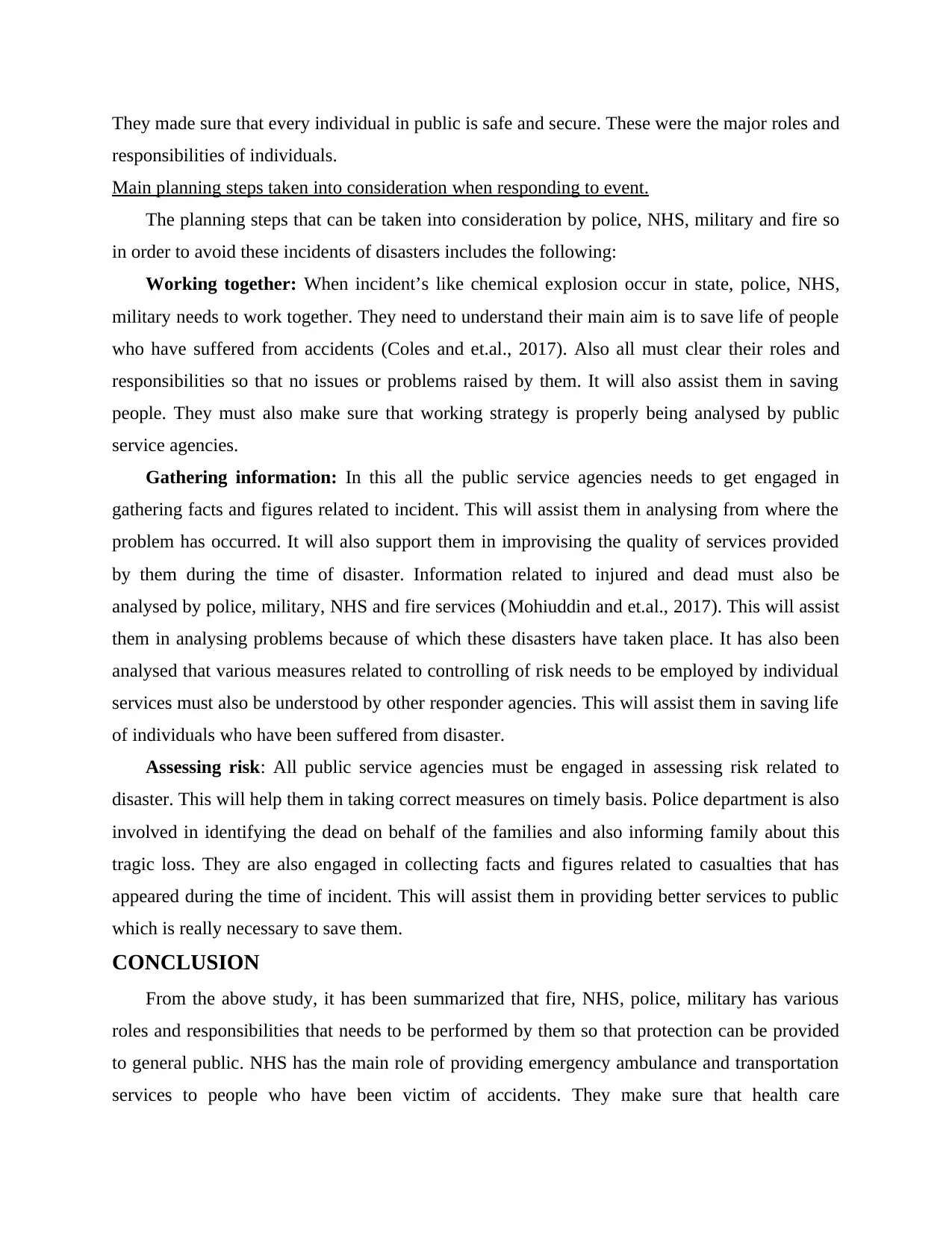
They made sure that every individual in public is safe and secure. These were the major roles and
responsibilities of individuals.
Main planning steps taken into consideration when responding to event.
The planning steps that can be taken into consideration by police, NHS, military and fire so
in order to avoid these incidents of disasters includes the following:
Working together: When incident’s like chemical explosion occur in state, police, NHS,
military needs to work together. They need to understand their main aim is to save life of people
who have suffered from accidents (Coles and et.al., 2017). Also all must clear their roles and
responsibilities so that no issues or problems raised by them. It will also assist them in saving
people. They must also make sure that working strategy is properly being analysed by public
service agencies.
Gathering information: In this all the public service agencies needs to get engaged in
gathering facts and figures related to incident. This will assist them in analysing from where the
problem has occurred. It will also support them in improvising the quality of services provided
by them during the time of disaster. Information related to injured and dead must also be
analysed by police, military, NHS and fire services (Mohiuddin and et.al., 2017). This will assist
them in analysing problems because of which these disasters have taken place. It has also been
analysed that various measures related to controlling of risk needs to be employed by individual
services must also be understood by other responder agencies. This will assist them in saving life
of individuals who have been suffered from disaster.
Assessing risk: All public service agencies must be engaged in assessing risk related to
disaster. This will help them in taking correct measures on timely basis. Police department is also
involved in identifying the dead on behalf of the families and also informing family about this
tragic loss. They are also engaged in collecting facts and figures related to casualties that has
appeared during the time of incident. This will assist them in providing better services to public
which is really necessary to save them.
CONCLUSION
From the above study, it has been summarized that fire, NHS, police, military has various
roles and responsibilities that needs to be performed by them so that protection can be provided
to general public. NHS has the main role of providing emergency ambulance and transportation
services to people who have been victim of accidents. They make sure that health care
responsibilities of individuals.
Main planning steps taken into consideration when responding to event.
The planning steps that can be taken into consideration by police, NHS, military and fire so
in order to avoid these incidents of disasters includes the following:
Working together: When incident’s like chemical explosion occur in state, police, NHS,
military needs to work together. They need to understand their main aim is to save life of people
who have suffered from accidents (Coles and et.al., 2017). Also all must clear their roles and
responsibilities so that no issues or problems raised by them. It will also assist them in saving
people. They must also make sure that working strategy is properly being analysed by public
service agencies.
Gathering information: In this all the public service agencies needs to get engaged in
gathering facts and figures related to incident. This will assist them in analysing from where the
problem has occurred. It will also support them in improvising the quality of services provided
by them during the time of disaster. Information related to injured and dead must also be
analysed by police, military, NHS and fire services (Mohiuddin and et.al., 2017). This will assist
them in analysing problems because of which these disasters have taken place. It has also been
analysed that various measures related to controlling of risk needs to be employed by individual
services must also be understood by other responder agencies. This will assist them in saving life
of individuals who have been suffered from disaster.
Assessing risk: All public service agencies must be engaged in assessing risk related to
disaster. This will help them in taking correct measures on timely basis. Police department is also
involved in identifying the dead on behalf of the families and also informing family about this
tragic loss. They are also engaged in collecting facts and figures related to casualties that has
appeared during the time of incident. This will assist them in providing better services to public
which is really necessary to save them.
CONCLUSION
From the above study, it has been summarized that fire, NHS, police, military has various
roles and responsibilities that needs to be performed by them so that protection can be provided
to general public. NHS has the main role of providing emergency ambulance and transportation
services to people who have been victim of accidents. They make sure that health care
⊘ This is a preview!⊘
Do you want full access?
Subscribe today to unlock all pages.

Trusted by 1+ million students worldwide

professional has been engaged in providing acute care to public so that their health can be
improved. Like this department is been engaged in doing search and rescue by saving life of
individual’s wo have suffered because of tragic incident’s.
improved. Like this department is been engaged in doing search and rescue by saving life of
individual’s wo have suffered because of tragic incident’s.
Paraphrase This Document
Need a fresh take? Get an instant paraphrase of this document with our AI Paraphraser
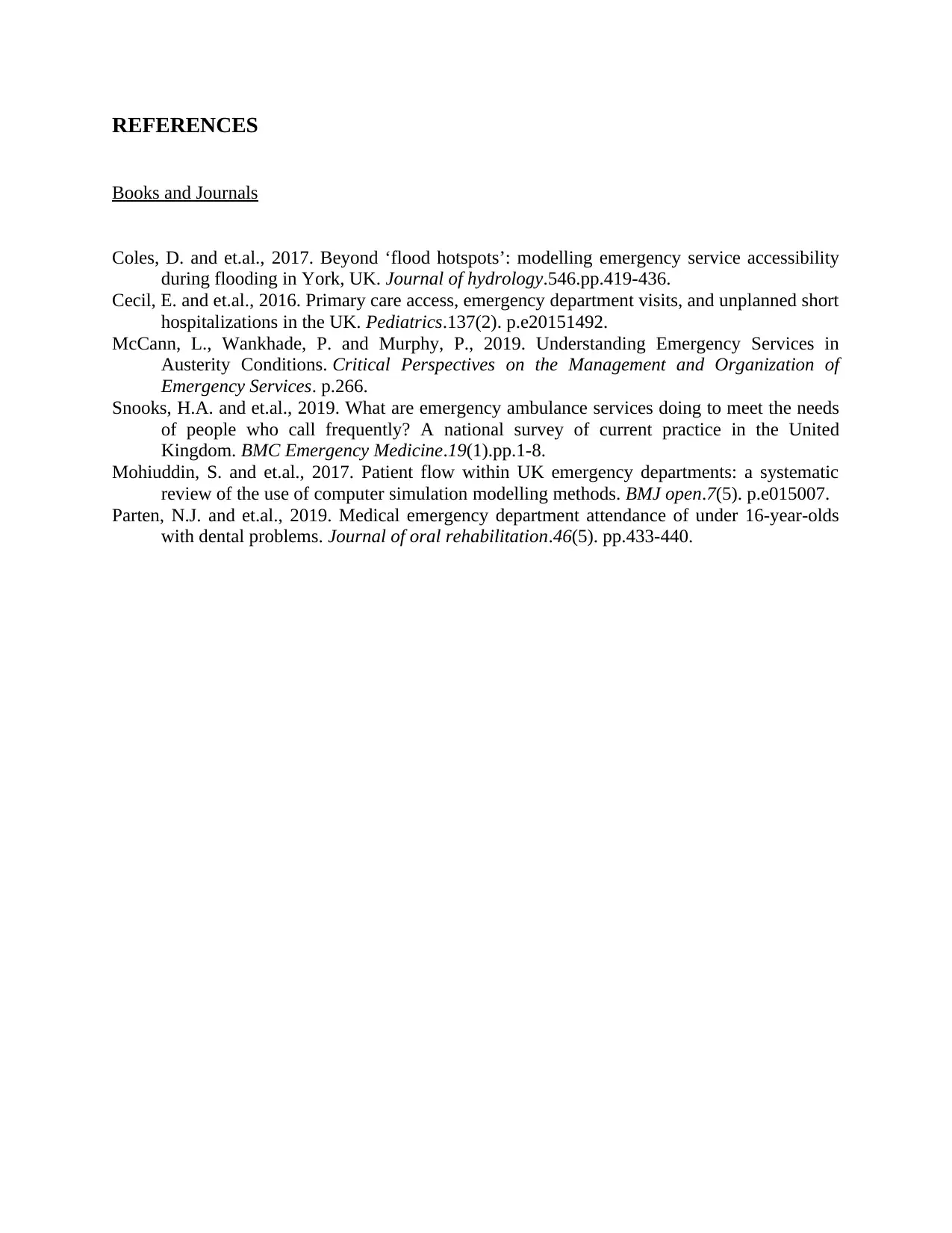
REFERENCES
Books and Journals
Coles, D. and et.al., 2017. Beyond ‘flood hotspots’: modelling emergency service accessibility
during flooding in York, UK. Journal of hydrology.546.pp.419-436.
Cecil, E. and et.al., 2016. Primary care access, emergency department visits, and unplanned short
hospitalizations in the UK. Pediatrics.137(2). p.e20151492.
McCann, L., Wankhade, P. and Murphy, P., 2019. Understanding Emergency Services in
Austerity Conditions. Critical Perspectives on the Management and Organization of
Emergency Services. p.266.
Snooks, H.A. and et.al., 2019. What are emergency ambulance services doing to meet the needs
of people who call frequently? A national survey of current practice in the United
Kingdom. BMC Emergency Medicine.19(1).pp.1-8.
Mohiuddin, S. and et.al., 2017. Patient flow within UK emergency departments: a systematic
review of the use of computer simulation modelling methods. BMJ open.7(5). p.e015007.
Parten, N.J. and et.al., 2019. Medical emergency department attendance of under 16‐year‐olds
with dental problems. Journal of oral rehabilitation.46(5). pp.433-440.
Books and Journals
Coles, D. and et.al., 2017. Beyond ‘flood hotspots’: modelling emergency service accessibility
during flooding in York, UK. Journal of hydrology.546.pp.419-436.
Cecil, E. and et.al., 2016. Primary care access, emergency department visits, and unplanned short
hospitalizations in the UK. Pediatrics.137(2). p.e20151492.
McCann, L., Wankhade, P. and Murphy, P., 2019. Understanding Emergency Services in
Austerity Conditions. Critical Perspectives on the Management and Organization of
Emergency Services. p.266.
Snooks, H.A. and et.al., 2019. What are emergency ambulance services doing to meet the needs
of people who call frequently? A national survey of current practice in the United
Kingdom. BMC Emergency Medicine.19(1).pp.1-8.
Mohiuddin, S. and et.al., 2017. Patient flow within UK emergency departments: a systematic
review of the use of computer simulation modelling methods. BMJ open.7(5). p.e015007.
Parten, N.J. and et.al., 2019. Medical emergency department attendance of under 16‐year‐olds
with dental problems. Journal of oral rehabilitation.46(5). pp.433-440.

1
⊘ This is a preview!⊘
Do you want full access?
Subscribe today to unlock all pages.

Trusted by 1+ million students worldwide
1 out of 9
Related Documents
Your All-in-One AI-Powered Toolkit for Academic Success.
+13062052269
info@desklib.com
Available 24*7 on WhatsApp / Email
![[object Object]](/_next/static/media/star-bottom.7253800d.svg)
Unlock your academic potential
Copyright © 2020–2025 A2Z Services. All Rights Reserved. Developed and managed by ZUCOL.





